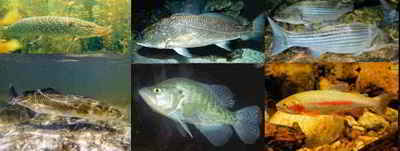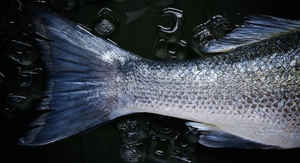Oregon State Fish
Chinook Salmon

(Oncorhynchus tshawytscha)
Adopted in 1961.
The Chinook salmon was declared the official state fish of Oregon by Senate Joint Resolution No. 26 in 1961 and is cross referenced in Chapter 186 of the Oregon Revised Statutes. The Chinook Salmaon, (Oncorhynchus tshawytscha,) also known as spring, king and tyee salmon. It is the largest of the Pacific salmons and the most highly prized for the fresh fish trade. Declared state fish by the 1961 Oregon Legislature, the Chinook Salmon is found from southern California to the Canadian Arctic. Record catches of 53 inches and 126 pounds have been reported.
Oregon State Fish: Chinook Salmon

The near elimination of beavers from most Oregon streams during the first part of this century, coupled with human activities such as grazing, logging, road building, dam building, urbanization and application of herbicides have impacted the health of Oregon's streams. Slow meandering streams, flowing over expanses of gravel and into heavily sedimented wetlands have been converted to fast, deeply channeled flows, which have often cut down to bedrock. This leaves little spawning area and even fewer places where young salmonids can avoid predators and survive the heavy winter floods.
Characteristics of the Chinook salmon
The Chinook salmon, Oncorhynchus tshawytscha, is the largest species in the Pacific salmon (Oncorhynchus) genus. Other commonly used names for the species include king salmon, Quinnat salmon, spring salmon and Tyee salmon. Chinook are anadromous fish native to the north Pacific Ocean and the river systems of western North America ranging from California to Alaska. A large Chinook is a prized and sought-after catch for a sporting angler. The flesh of the salmon is also highly valued for its dietary nutritional content, which includes high levels of important omega-3 fatty acids.
- Anal fin is not sickle-shaped: leading edge of anal fin is shorter than length of base.
- Anal fin leading edge is white.
- Adipose fin has clear center or "window."
- Dorsal fin has dark leading edge and white tip.
- Species has 16-18 branchiostegols.
- Species usually has 135-185 pyloric caeca.
Distribution

- Chinook are usually found in moderate to large streams.
- Main channel is used for rearing.
- In large streams, 8-10 cm fish live in faster, deeper water than coho.
- Chinook may rear in estuaries of larger rivers.
Freshwater residence time
Chinook may form races with some rearing » 1 year, some 90 days or less depending on type. Southern populations frequently stay 90 days and northern populations are more likely to stay up to a year, but can be variable in all areas.
Chinook vs. coho
- Chinook have "clear window" in adipose.
- Chinook do not have sickle-shaped anal fins or white and black stripes on leading edges of anal and dorsal fins.
- Coho have sickle-shaped anal fins, with leading edges longer than length of base of anal fins. Leading edges of anal and dorsal fins have white and black stripes.
- Chinook frequent main stems of moderate to large rivers. Coho are found in all accessible stream reaches, including seasonally wetted areas.
Oregon Revised Statutes
The Chinook salmon was declared the official state fish of Oregon by Senate Joint Resolution No. 26 in 1961 and is cross referenced in Chapter 186 of the Oregon Revised Statutes.
Volume 5, Chapters 171-200
TITLE 19 MISCELLANEOUS MATTERS RELATED TO GOVERNMENT AND PUBLIC AFFAIRS
CROSS-REFERENCES
186. State Emblems; State Boundary
Chinook salmon declared to be official fish, SJR 26 (1961)
Taxonomic Hierarchy: Chinook Salmon
Kingdom: Animalia - animals
Phylum: Chordata - chordates
Subphylum: Vertebrata - vertebrates
Class: Actinopterygii (ray-finned fishes)
Order: Salmoniformes
Family: Salmonidae (Salmonids), subfamily: Salmoninae
Genus: Oncorhynchus
Species: tshawytscha - Chinook salmon








